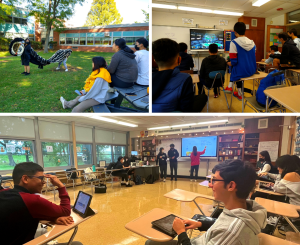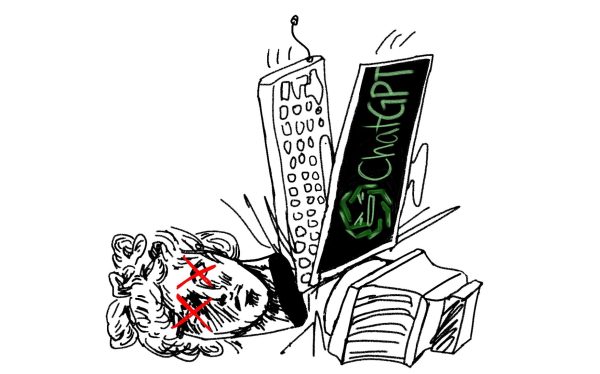The Cheat Code to Assessment

Sneaking a peek—Although traditional forms of cheating aren’t prominent with online learning, students have found much less conspicuous ways of getting their answers.
March 8, 2021
With five minutes left and sixteen more multiple choices to go, you might feel that you are, well, screwed. But not when you wield the power of Google. With just a little digging, you managed to come up with the answer key, an exam concocted by a teacher halfway across the country. Nonetheless, its questions are the same ones that are in front of you, leaving you ample time to send it to all of your friends and mess around before bubbling it all in. The results are all that count, and the ends justify the means.
An online setting has made cheating extremely easy. There is a low risk of getting caught, and limitless resources to choose from. First, students can easily collaborate or share answers during an exam. Second, while most exams are open-notes this year, teachers still expect students to read, think, and respond. But the internet has all of the questions and answers a student could want, and all it takes is a little digging to find the solution. Others who are following the same curriculum post questions online with answers ripe for the picking. Even if a specific question isn’t available, students find similar questions or use relevant tools to arrive at an answer.
In response, teachers have used different programs, and adjusted their rules in order to hinder the efforts of cheaters. As mentioned before, many teachers have opted for an open book format, but this does not discourage cheaters; rather, their cheating is enabled under the guise of it being “open book”. The struggle between cheaters and teachers will become similar to an arms race. Teachers make students unmute while taking a test; cheaters just text their friends instead of talking. Teachers put a lockdown browser in place; cheaters just use another device to consult the internet. Not only will this back and forth be a hassle for teachers, but it will also be an obstacle to integrous students. Instead of aimlessly escalating the fight against cheating, teachers should try less traditional forms of teaching and assessment.
The painfully obvious problem of cheating is that it is unethical, but that’s an overused argument that’s presented to students every year. The crux of the problem is that cheating undermines a teacher’s ability to help students in areas that they struggle in. Cheating prevents teachers from seeing what a student needs help with, and it’s unfortunate that most students do not care about this part of the process because they are fixated on their grade. The key to getting around cheating while also continuing assessment requires a change: we either have to change the assessments or change the way students see the assessments.
A form of learning worth looking into is Project Based Learning, where the project is the curriculum. According to the Buck Institute of Education, leaders in advocating for PBL, “Project Based Learning is a teaching method in which students gain knowledge and skills by working for an extended period of time to investigate and respond to an authentic, engaging, and complex question, problem, or challenge.” Unlike traditional teaching, where the teacher spoon feeds students information and herds the class, PBL allows students to come up with an idea and determine how they wish to solve a problem. They are accountable for their own work, and whatever they learn is their own doing, not the work of someone else. Teachers take on more of an advisory role, setting the parameters and then offering help to students who need it. Students are autonomous in their work, entirely hands-on, which has proven to be more effective than traditional teaching. According to Stephanie Bell, who was featured in the education journal The Clearing House, ”Students were taught using traditional math programs at one school and PBL at another school. Three times as many PBL students achieved the highest possible grade on the national exam than the students at a traditional school.” While this method of teaching is not traditional, it still provides the same results that teachers and administrators want. Students learn essential skills that they wouldn’t have otherwise learned in a normal lecture. This structure also gives students the option to collaborate and learn from the work of others, which makes it a nice break from the monotony of Zoom. Many classes that rely on lectures as the main medium of instruction can easily become repetitive and boring. With PBL, students would be more engaged and more inclined to take control of their learning, creating a more lively environment.
Completely changing the structure of a class can be daunting, but most classes have already used projects as a means of teaching content. Labs, research papers, and DBQs are all projects that can be used to teach content, but are often culminating projects, meant to demonstrate aptitude for a subject. If the purpose of projects becomes getting students to learn, rather than assessing that learning, teachers could phase out traditional testing.
If PBL seems too open-ended, teachers can try assessing a student’s knowledge solely through participation or classwork, where the stakes are lower. Classes where students have to participate to get points, or work with others on classwork, will truly demonstrate a student’s aptitude, without any subversion. Even if that’s too much to ask, teachers can add test correction policies that deemphasize the importance of a test in the eyes of students, while also working with them to improve problem areas. Again, fixation on the result rather than the work is what drives many to cheat, so turning the process into the assessment should reduce cheating.
Lots of classes focus around preparing students for an end of year final, where students are prepared as test takers rather than thinkers. It is probably easier for teachers to prepare students by making them do sample problems since it is more formulaic and finals always ask the same things. But again, if we change the focus from training for the test at the end of the year to learning the underlying skills necessary to take that test, we can create a more proactive learning environment, one that doesn’t rely on tests. It is simply a matter of reframing the lesson to be more in the hands of the student than the teacher.
The pandemic has been awful, but there is a silver lining. Schools have taken out paper and made schoolwork more centralized: teachers who used paper have been forced to adapt. Maybe a similar change is meant to happen with our testing. Given the circumstances and how cheating has undermined the legitimacy of testing, maybe it is time for an overdue change.

















